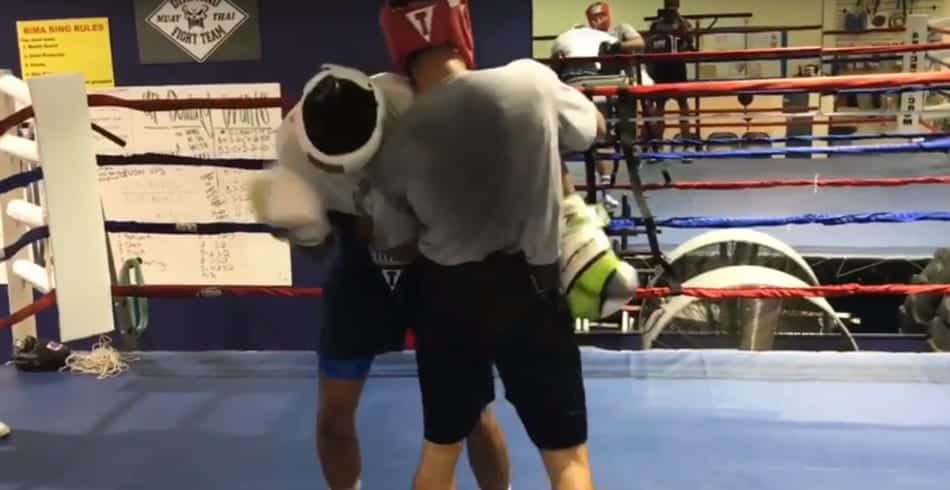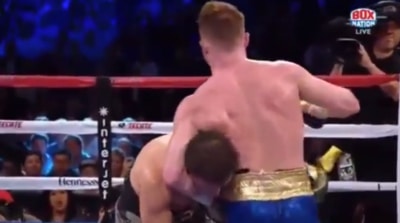
The battle over clinching in boxing is a longstanding one that has boxing fans ready to jump into the ring themselves. It’s a technique used in pretty much every match you’ll ever see. But if you’re not familiar with it, it can seem like nothing but an annoying break in the action.
Why is clinching allowed in boxing? Clinching is an effective defensive technique meant to stop your opponent’s momentum. It is only allowed for a short period before the referee will break it up. By allowing clinching, matches can go longer because boxers use this method as an energy-saving defense in a sport with a grueling work rate.
In any sport, you have techniques that are essential to a winning strategy, even if they are controversial or unliked by many. Clinching is a divisive technique, but it is still essential to a boxer’s arsenal of skills.
Also clinching is one the most natural way of fighting that people use (a lot of street fight end up quickly in a clinch). So I personally don’t think it should be banned at all.
What is the Purpose of a Clinch?
Boxers would love to be able to stay on the offensive throughout a match. But having a thorough defensive strategy is the key to victory for many boxers. It’s a strategic maneuver that needs to be a part of your skillset if you want to be a competitive boxer.
Learning patience and understanding when to deploy this method can be equally as effective as it can be frustrating. When boxers face an offensive-minded opponent, it quickly becomes aggravating for them and that becomes a strategy as well. Frustration breeds mistakes.
Lennox Lewis and Guillermo Rigondeaux were masters of this technique and used it to their advantage at the exact right times. By using the right techniques and knowing when to use it, it can disrupt the rhythm of an opponent.
Rhythm is an important, but often overlooked, element of boxing. When a boxer goes on the offensive and finds that groove, you see the momentum shift to their advantage. When fighters use a proper clinch at those moments, it can be a lifesaver.
Here are the instances boxers will typically use clinching:
- To shift momentum when they are taking a pounding
- To neutralize an attack as it builds, before it happens
- To break up their opponent’s rhythm when they feel them hitting a sweet spot
- A strategic maneuver when they know a clinch alters their opponent’s mental process
- To regain their momentum and energy if they feel worn down
- If they have taken a hard hit and need to stabilize themselves
- A boxer needing to find their way out of a corner
The Debate of Clinching
It’s no secret in the boxing community that clinching is not everyone’s favorite move. Some consider it to be a cop-out or a way to avoid taking a hit. Others argue that it helps prolong a match because of the intensity of the sport.
Here are some of the main arguments on both sides of this match:
| Arguments for Clinching | Arguments Against Clinching |
| Extends the match by allowing this brief respite from such an intense sport | Makes the match boring or annoying to watch because of the breaks in the action |
| One of many different defensive techniques that take skill and aptitude | It’s a way for a boxer who’s not as physically fit, to slow it down the pace |
In Favor of Clinching
The arguments for clinching all come down to the fact that it is a defensive technique. All sports have those moments and techniques that some fans won’t be a fan of, but they still serve a purpose.
In football, if a team is winning towards the end of a game, they may hold the ball more and move it around to keep possession to ensure their victory. In basketball, a team that’s winning will wait until the last second on the shot clock to shoot the ball to waste time towards the end.
These are still techniques and skills that fit into their respective sports to create an advantage. Is it the most exciting thing to watch? Definitely not. But it is a logical strategy that will help ensure a win.
You also must look at the longevity of a match. If clinching wasn’t allowed, matches may not be able to maintain the length. Clinching shouldn’t be used simply because a boxer is tired. But in many cases, that will be the case. It could be that they need those very few moments to recompose themselves and get back into the match.
Without those moments, these matches may not have the length that we all want when we sit down to a big fight in anticipation.
Why People are Opposed to Clinching
When boxing fans sit down to watch the big fight, they are expecting just that: a fight. Those opposed to clinching find the breaks in the action to be distracting, annoying, and frustrating when they want to see action.
While a boxer is taking a beating and they need to shift that momentum, fans of the sport are on their feet cheering for the action. So, when a clinch happens at that moment, it can easily deflate an arena or living room party of fans who were appreciating a series of blows.
The other major argument is that boxers just use it as a way to avoid taking hits or battling it out. The last thing any fan of the sport wants to see is someone squeak by in a fight that they were not ready for, simply because they keep clinching every time they get worn out.
This is where fans, athletes, and coaches can all get testy. It is one thing to use it as a defensive technique once or twice in a match where it is skillfully deployed and followed up by impressive offense. It is another to see a boxer that hasn’t been hitting the gym often enough use it as a scapegoat to stumble through a fight they have no place fighting.
“The hero and the coward both feel the same thing. But the hero uses his fear, projects it onto his opponent, while the coward runs. It’s the same thing, fear, but it’s what you do with it that matters.” -Cus D’amato
Source: Evolve
Allowing clinching in boxing brings an interesting perspective on both sides. This quote from famed manager and trainer, Cus D’amato, can be interpreted from both sides of the clinching debate. Are you a coward running when you clinch? Or are you using it against your opponent to help yourself live another round and land your next big sequence?
Rules for on Clinching
Clinching is allowed for short periods as a defensive measure. So, boxers should always be aware of the best ways to deploy this tactic at the proper times. While it is allowed, a boxer cannot clinch for more than a few seconds, and the opponent will typically try to break out of it if they were the one in the position of power before it happened.
Let’s Get Official: One of the main rules when it comes to clinching is regarding the end of the clinch. When the referee breaks you from a clinch, you have to take a full step back; you cannot immediately hit your opponent–that’s called “hitting on the break” and is illegal.
Source: BoxRec
Clinching in a Self-Defense Scenario
Yes, clinching is allowed in boxing, but one of the biggest drawbacks of the sport as a self-defense tool is that boxers don’t work in the clinch (like Muay Thai fighters or MMA guys). In the clinch boxers usually do one of those 3 things:
- Try to get double overhooks (hugging both their opponents’ hands to stop their punches)
- Getting over-under hooks and waiting for the ref to separate them. Under hook is when you hug your opponent with your arm under his armpit. That is a 50/50 situation when both fighters have one over and one underhook.
- Getting a headlock. When a taller boxer faces an aggressive shorter opponent he can get a headlock with his lead arm as his opponent is rushing forward. That was Wladimir Kiltscko’s favorite way of clinching.
All those clinching methods are effective when you want to stop the other guy’s punches but that doesn’t mean he can’t knee, headbutt you or take you down. For example, in a self-defense situation if you take double overhooks nothing is stopping the attacker to headbutt you in the face or to get a body lock (to hug you and lock his hands), brake your posture and take you down. The same is true when using this weird lead arm headlock.
That’s why if you focus is more on the self-defense side of the sport and not the competition one, I think you need to always try to perfect your boxing skills but also learn other combat sports such as Muay Thai, Wrestling and BJJ.
Allowing Clinching in Boxing
Clinching is a technique that will always bring controversy into the conversation surrounding it. When an out of shape boxer uses it too often, fans will typically tell them to cut it out and go hit the gym. But when used correctly, and not too frequently, it adds value to the sport and brings a different element of defensive strategies.




Dima, great job! This was a fair assessment of the pros and cons of the use of clinching. I personally think that most boxing traditionalists and enthusiasts see clinching as an integral, necessary part of the sport, which given a good ref and a savvy opponent, should never become a real problem for any fighter to deal with. I think that more casual fans get exasperated too quickly with lots of aspects of boxing (particularly with clinching), but are not taking into account what the boxers go through. Also, winning a fight by all legal means should be a fighter’s goal, so the boxer who doesn’t employ a necessary, effective strategy to avoid excessive clinching by his opponent, is also culpable in the slow-downs or frequent stoppages in action. Lastly, and for casual fans, a boxing match simply cannot and will not always be a non-stop action endeavor; a winning strategy alone, might not allow for this. All boxers are not equal, but the proper use of all legal means to win, can help to equalize a match, which is what I think most want at the end of the day… competitive bouts!
Clinching is the main reason I no longer watch boxing. In many matches I see more clinch time than boxing time. The optimum version of any sport is if you do not notice the referee (umpire, judge, …), when I see the referee dripping sweat because of how hard they are working to separate the fighters, any joy of watching is completely gone. Clinching should be treated the same as grabbing the ropes or rabbit punching. A few warnings and then take points. Maybe I will come back to watch.
I agree with this it ruins the match when overused. I’m for it being banned or severely restricted as the sport is boxing, not grappling! You watch judo, wrestling or MMA if you want grappling or if you want it mixed with boxing then muay thai will satisfy that. It is usually a coward move to clinch. I’m a martial artist not a boxer but I’ve experienced it with what was meant to be a friendly sparring boxing match, the opponent who I intended to go easy on went for a big headshot straight away which got me riled up. I outboxed them out of annoyance and anger and clearly outmatched they tried to clinch near the end, for me to just throw them on the ground. (He was a frequent clincher in sparring, his excuse is habits from schoolfights….)
Anyway again I take ‘boxing’ literally, a sport/fighting style (Albeit an incomplete one, no fighter should exclusively rely on 2/4 limbs, same applies for kicking styles) that employs the arms to strike with, NOT some hybrid that mixes grabbing someone. If you don’t want to get hit, dodge and block, don’t get cheap by grabbing them. Yes stamina is an issue so clinching gets some breathing time, same as groundwork in MMA, I’ve used it to get some respite often when there’s a lull in the action. Yes it’s necessary we’re not tireless machines, still though boxing is intended to be a pure striking sport. And I think it was pointed out, clinching can deplete a lot of energy too with struggling fighters as grappling is very tiring, which defeats the purpose for those trying to conserve energy by clinching.